-
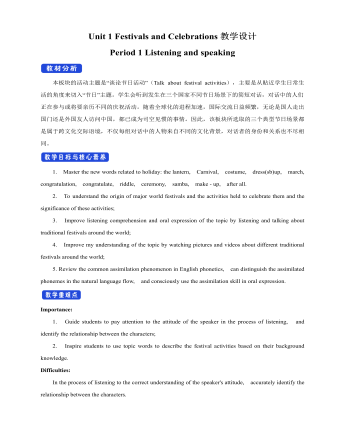
新人教版高中英语必修3Unit 1 Festivals and Celebrations教学设计一
本板块的活动主题是“谈论节日活动”(Talk about festival activities),主要是从贴近学生日常生活的角度来切入“节日”主题。学生会听到发生在三个国家不同节日场景下的简短对话,对话中的人们正在参与或将要亲历不同的庆祝活动。随着全球化的进程加速,国际交流日益频繁,无论是国人走出国门还是外国友人访问中国,都已成为司空见惯的事情。因此,该板块所选取的三个典型节日场景都是属于跨文化交际语境,不仅每组对话中的人物来自不同的文化背景,对话者的身份和关系也不尽相同。1. Master the new words related to holiday: the lantern, Carnival, costume, dress(sb)up, march, congratulation, congratulate, riddle, ceremony, samba, make - up, after all. 2. To understand the origin of major world festivals and the activities held to celebrate them and the significance of these activities;3. Improve listening comprehension and oral expression of the topic by listening and talking about traditional festivals around the world;4. Improve my understanding of the topic by watching pictures and videos about different traditional festivals around the world;5. Review the common assimilation phenomenon in English phonetics, can distinguish the assimilated phonemes in the natural language flow, and consciously use the assimilation skill in oral expression. Importance:1. Guide students to pay attention to the attitude of the speaker in the process of listening, and identify the relationship between the characters;2. Inspire students to use topic words to describe the festival activities based on their background knowledge. Difficulties:In the process of listening to the correct understanding of the speaker's attitude, accurately identify the relationship between the characters.
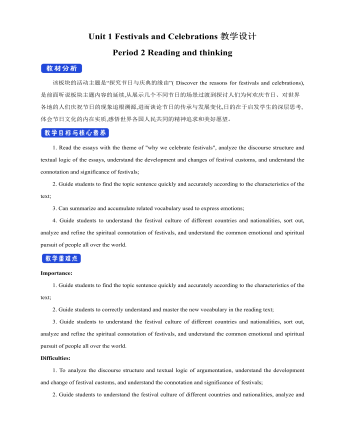
新人教版高中英语必修3Unit 1 Festivals and Celebrations教学设计三
*wide range of origins(= a great number of different origins, many kinds of origins)*It featured a parade and a great feast with music, dancing, and sports. (=A parade and a great feast with music, dancing, and sports were included as important parts of the Egyptian harvest festival.)*.. some traditions may fade away and others may be established.(= Some traditions may disappear gradually, while other new traditions may come into being.)Step 6 Practice(1) Listen and follow the tape.The teacher may remind the students to pay attention to the meaning and usage of the black words in the context, so as to prepare for the completion of the blanks in activity 5 and vocabulary exercises in the exercise book.(2) Students complete the text of activity 5 by themselves.The teacher needs to remind the students to fill in the blanks with the correct form of the vocabulary they have learned in the text.Students exchange their answers with their partners, and then teachers and students check their answers.(3)Finish the Ex in Activity 5 of students’ book.Step 7 Homework1. Read the text again, in-depth understanding of the text;2. Discuss the origin of festivals, the historical changes of related customs, the influence of commercial society on festivals and the connotation and essential meaning of festivals.3. Complete relevant exercises in the guide plan.1、通过本节内容学习,学生是否理解和掌握阅读文本中的新词汇的意义与用法;2、通过本节内容学习,学生能否结合文本特点快速而准确地找到主题句;3、通过本节内容学习,学生能否理清论说文的语篇结构和文本逻辑,了解节日风俗发展与变迁,感悟节日的内涵与意义。
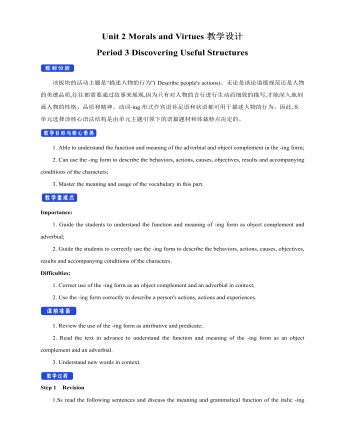
新人教版高中英语必修3Unit 2 Morals and Virtues教学设计三
The joke set her crying.这个玩笑使她哭起来。Step 5 ReadingActivity 31. Students read the small text in activity 3. The teacher provides several small questions to check whether students understand the content of the text and the ideographic function of the -ing form in the text.*Where are those people?*Why did Dr Bethune come to China?*How did he help the Chinese people during the war?*What did Chairman Mao Zedong say about him?2. Ss try to rewrite some sentences using the -ing form. Then check the answers. When checking the answers, the teacher can ask different students to read the rewritten sentences and give comments.Answers:1. he became very interested in medicine, deciding to become a doctor.2. …after hearing that many people were dying in the war.3. Helping to organise hospitals, he taught doctors and nurses, and showed people how to give first aid./ He helped to organise hospitals, teaching doctors and nurses, and showing people how to give first aid.4. …praising Dr Bethune as a hero to be remembered in China.Step 6 PracticeActivity 4Students complete grammar activities 2 and 3 on page 69 of the workbook.Step 6 Homework1. Understand and master the functions and usage of the -ing form;2. Finish the other exercises in Using structures.1、通过本节内容学习,学生是否理解和掌握动词-ing形式作宾语补足语语和状语语的功能和意义;2、通过本节内容学习,学生能否正确使用动词-ing形式描述人物的行为、动作及其经历;3、通过本节内容学习,学生能否独立完成练习册和导学案中的相关练习。
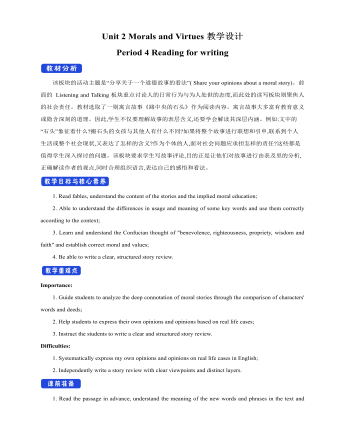
新人教版高中英语必修3Unit 2 Morals and Virtues教学设计四
3.Teachers ask different groups to report the answers to the questions and ask them to try different sentence patterns.The teacher added some sentence patterns for students to refer to when writing.Step 4 Writing taskActivity 51.Write the first draft.Students first review the evaluation criteria in activity 5, and then independently complete the draft according to the outline of activity 4, the answers to the questions listed in the group discussion and report, and the reference sentence pattern.2.Change partners.The teacher guides the students to evaluate their partner's composition according to the checklist of activity 5 and proposes Suggestions for modification.3.Finalize the draft.Based on the peer evaluation, students revise their own compositions and determine the final draft.Finally, through group recommendation, the teacher selects excellent compositions for projection display or reading aloud in class, and gives comments and Suggestions.Step 5 Showing writingActivity 5T call some Ss to share their writing.Step 6 Homework1. Read the passage in this section to better understand the passage.2. Carefully understand the hierarchical structure of the article, and deeply understand the plot of the story according to the causes, process and results;3. Independently complete the relevant exercises in the guide plan.1、通过本节内容学习,学生是否理解和掌握阅读文本中的新词汇的意义与用法;2、通过本节内容学习,学生能否通过人物言行的对比分析道德故事的深层内涵;3、通过本节内容学习,学生能否根据故事的起因、经过和结果来深入理解故事的情节,从而了解文章的层次结构;4、结合现实生活案例发表自己的见解和看法,写一篇观点明确、层次分明的故事评论。
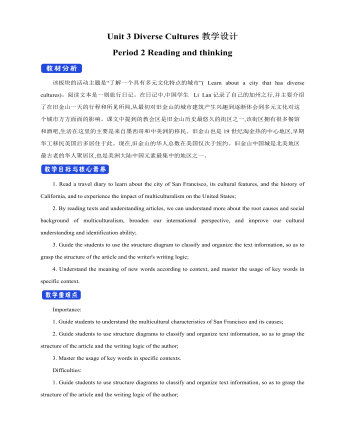
新人教版高中英语必修3Unit 3 Diverse Cultures教学设计二
(2)Consolidate key vocabulary.Ask the students to complete the exercises of activity 6 by themselves. Then ask them to check the answers with their partners.(The first language:Damage of the 1906 San Francisco earthquake and fire.A second language: Yunnan - one of the most diverse provinces in China).Step 5 Language points1. The teacher asks the students to read the text carefully, find out the more words and long and difficult sentences in the text and draw lines, understand the use of vocabulary, and analyze the structure of long and difficult sentences.2. The teacher explains and summarizes the usage of core vocabulary and asks the students to take notes.3. The teacher analyzes and explains the long and difficult sentences that the students don't understand, so that the students can understand them better.Step 6 Homework1. Read the text again, in-depth understanding of the text;2. Master the use of core vocabulary and understand the long and difficult sentences.3. Complete relevant exercises in the guide plan.1、通过本节内容学习,学生是否理解和掌握阅读文本中的新词汇的意义与用法;2、通过本节内容学习,学生能否结合文本特点了解文章的结构和作者的写作逻辑;3、通过本节内容学习,学生能否了解旧金山的城市风貌、文化特色,以及加利福尼亚州的历史,体会多元文化对美国的影响。
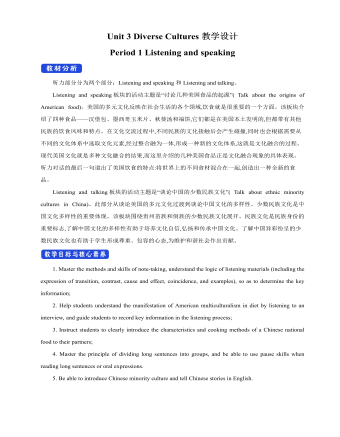
新人教版高中英语必修3Unit 3 Diverse Cultures教学设计一
Activity 81.Grasp the main idea of the listening.Listen to the tape and answer the following questions:Who are the two speakers in the listening? What is their relationship?What is the main idea of the first part of the listening? How about the second part?2.Complete the passage.Ask the students to quickly review the summaries of the two listening materials in activity 2. Then play the recording for the second time.Ask them to complete the passage and fill in the blanks.3.Play the recording again and ask the students to use the structure diagram to comb the information structure in the listening.(While listening, take notes. Capture key information quickly and accurately.)Step 8 Talking Activity 91.Focus on the listening text.Listen to the students and listen to the tape. Let them understand the attitudes of Wu Yue and Justin in the conversation.How does Wu Yue feel about Chinese minority cultures?What does Justin think of the Miao and Dong cultures?How do you know that?2.learn functional items that express concerns.Ask students to focus on the expressions listed in activity. 3.And try to analyze the meaning they convey, including praise (Super!).Agree (Exactly!)"(You're kidding.!)Tell me more about it. Tell me more about it.For example, "Yeah Sure." "Definitely!" "Certainly!" "No kidding!" "No wonder!" and so on.4.Ask the students to have conversations in small groups, acting as Jsim and his friends.Justin shares his travels in Guizhou with friends and his thoughts;Justin's friends should give appropriate feedback, express their interest in relevant information, and ask for information when necessary.In order to enrich the dialogue, teachers can expand and supplement the introduction of Miao, dong, Lusheng and Dong Dage.After the group practice, the teacher can choose several groups of students to show, and let the rest of the students listen carefully, after listening to the best performance of the group, and give at least two reasons.
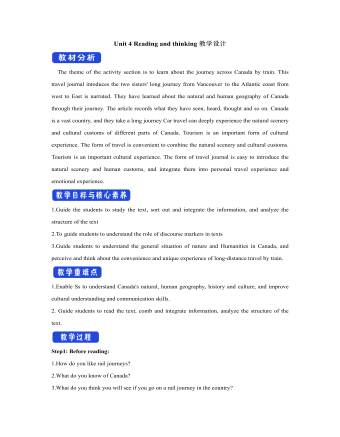
新人教版高中英语选修2Unit 4 Reading and thinking教学设计
【词汇精讲】highlight n.最好或最精彩的部分 vt.突出;强调;使醒目One of the highlights of the trip was seeing the Taj Mahal.这次旅行的亮点之一是参观泰姬陵。Your resume should highlight your skills and achievements.你的简历应该突出你的技能和成就。The report highlights the major problems facing society today.报告强调了当今社会所面临的主要问题。I’ve highlighted the important passages in yellow.我用黄色标出了重要段落。7.Edmonton is freezing cold in winter,with daily temperatures averaging -10 ℃.埃德蒙顿冬季寒冷,日平均气温为-10°C。【词汇精讲】freezing adj.极冷的;冰冻的Leave a basin of water outside in freezing weather.在冰冻的天气里,放一盆水在室外。It’s freezing cold outside so wear a warm coat.外面超冷的,所以穿一个暖和一点的外套吧。8.It was not until 9:30 a.m.that they finally reached the capital of Ontario,Toronto.直到上午9时30分,他们才终于到达多伦多的首府安大略省。【句式剖析】本句是一个强调句,强调的是句子的时间状语until 9:30。含有not...until...的句子的强调句为It is not until...that...,that后面的句子要用肯定形式。It was not until then that I suddenly realized nobody was happier than I was.直到那时我才突然意识到没有人比我更幸福了。
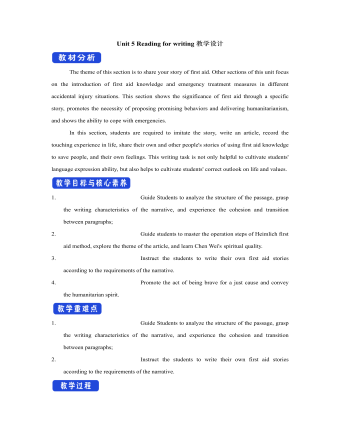
新人教版高中英语选修2Unit 5 Reading for writing教学设计
你校英语报计划出版一期急救常识专刊,现面向全校学生公开征集稿件,你有意参加。请你根据下面提示内容,用英语写一篇短文,介绍在车祸现场对伤者进行急救的方法和步骤。1.确保现场的安全;2.询问伤者,确保其呼吸正常;3.检查伤口,如流血则应采取止血措施;4.如需急救,确保其处于康复位置。注意:1.词数80左右;2.可以适当增加细节,以使行文连贯。参考词汇:康复位置 recovery positionAs we all know, having a knowledge of first aid can make a great difference in our daily life. If a traffic accident happens and someone is injured, the following steps can be used to treat the injured.In the first place, we should make sure that the accident scene is safe so that we won’t get hurt. We should ask the injured person if he is OK, and see if he is breathing. What’s more, we should check for cuts and wounds. If he is bleeding badly, it is vital that we should try to stop the bleeding by applying pressure to the injury. This is because if a person loses too much blood, he may die. If necessary, take the injured person to the hospital as soon as possible.Do remember: when giving first aid, please be sure to place the person in a recovery position.
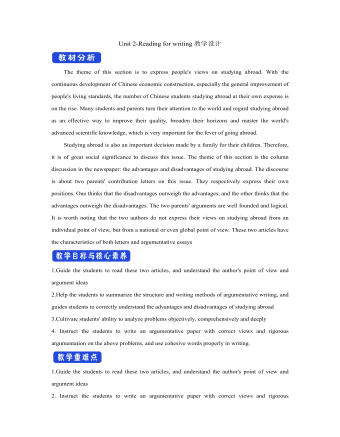
新人教版高中英语选修2Unit 2 Reading for writing教学设计
The theme of this section is to express people's views on studying abroad. With the continuous development of Chinese economic construction, especially the general improvement of people's living standards, the number of Chinese students studying abroad at their own expense is on the rise. Many students and parents turn their attention to the world and regard studying abroad as an effective way to improve their quality, broaden their horizons and master the world's advanced scientific knowledge, which is very important for the fever of going abroad. Studying abroad is also an important decision made by a family for their children. Therefore, it is of great social significance to discuss this issue. The theme of this section is the column discussion in the newspaper: the advantages and disadvantages of studying abroad. The discourse is about two parents' contribution letters on this issue. They respectively express their own positions. One thinks that the disadvantages outweigh the advantages, and the other thinks that the advantages outweigh the disadvantages. The two parents' arguments are well founded and logical. It is worth noting that the two authors do not express their views on studying abroad from an individual point of view, but from a national or even global point of view. These two articles have the characteristics of both letters and argumentative essays1.Guide the students to read these two articles, and understand the author's point of view and argument ideas2.Help the students to summarize the structure and writing methods of argumentative writing, and guides students to correctly understand the advantages and disadvantages of studying abroad3.Cultivate students' ability to analyze problems objectively, comprehensively and deeply
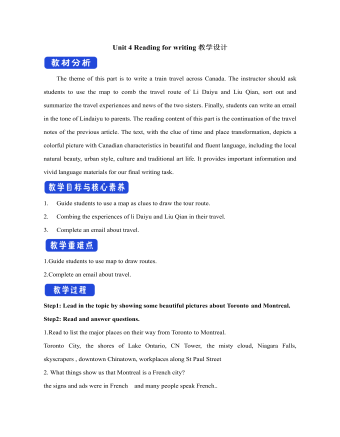
新人教版高中英语选修2Unit 4 Reading for writing教学设计
假定你是英国的Jack,打算来中国旅行,请你给你的中国笔友李华写一封信,要点如下:1.你的旅行计划:北京→泰山→杭州;2.征求建议并询问他是否愿意充当你的导游。注意:1.词数80左右(开头和结尾已给出,不计入总词数);2.可以适当增加细节,以使行文连贯。参考词汇:故宫 the Forbidden City;泰山 Mount TaiDear Li Hua,I'm glad to tell you that 'm going to visit China.First,I am planning to visit Beijing,the capitalof China,where I am looking forward to enjoying the Great Wall,the Forbidden City and somebeautiful parks.Then I intend to go to visit Mount Tai in Shandong Province.I've heard that it is one ofthe most famous mountains in China and I can't wait to enjoy the amazing sunrise there.After that,I amalso going to Hangzhou.It is said that it is a beautiful modern city with breathtaking natural sights,among which the West Lake is a well- known tourist attraction.What do you think of my travel plan? Will you act as my guide? Hope to hear from you soon.
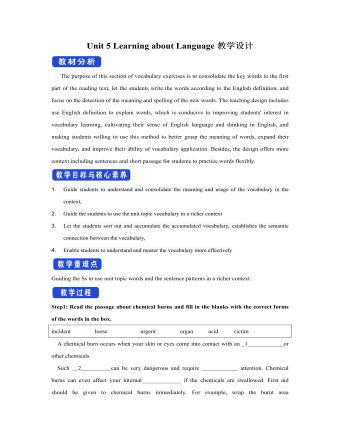
新人教版高中英语选修2Unit 5 Learning about Language教学设计
The purpose of this section of vocabulary exercises is to consolidate the key words in the first part of the reading text, let the students write the words according to the English definition, and focus on the detection of the meaning and spelling of the new words. The teaching design includes use English definition to explain words, which is conducive to improving students' interest in vocabulary learning, cultivating their sense of English language and thinking in English, and making students willing to use this method to better grasp the meaning of words, expand their vocabulary, and improve their ability of vocabulary application. Besides, the design offers more context including sentences and short passage for students to practice words flexibly.1. Guide students to understand and consolidate the meaning and usage of the vocabulary in the context, 2. Guide the students to use the unit topic vocabulary in a richer context3. Let the students sort out and accumulate the accumulated vocabulary, establishes the semantic connection between the vocabulary,4. Enable students to understand and master the vocabulary more effectivelyGuiding the Ss to use unit topic words and the sentence patterns in a richer context.Step1: Read the passage about chemical burns and fill in the blanks with the correct forms of the words in the box.
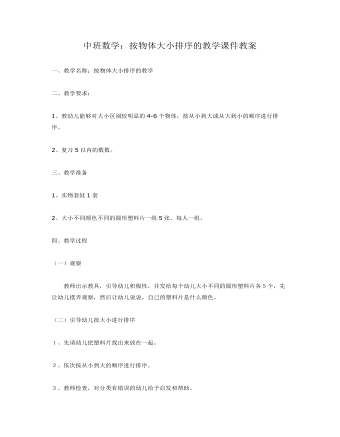
中班数学:按物体大小排序的教学课件教案
二、教学要求:1、教幼儿能够对大小区别较明显的4-6个物体,按从小到大或从大到小的顺序进行排序。2、复习5以内的数数。三、教学准备1、实物套娃1套2、大小不同颜色不同的圆形塑料片一组5张,每人一组。
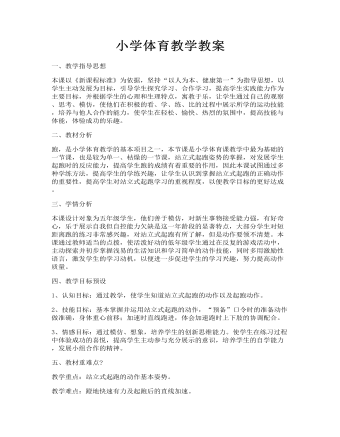
小学体育教学教案
二、教材分析跑,是小学体育教学的基本项目之一,本节课是小学体育课教学中最为基础的一节课,也是较为单一、枯燥的一节课,站立式起跑姿势的掌握,对发展学生起跑时的反应能力,提高学生跑的成绩有着重要的作用,因此本课试图通过多种学练方法,提高学生的学练兴趣,让学生认识到掌握站立式起跑的正确动作的重要性,提高学生对站立式起跑学习的重视程度,以便教学目标的更好达成。三、学情分析本课设计对象为五年级学生,他们善于模仿,对新生事物接受能力强,有好奇心,乐于展示自我但自控能力欠缺是这一年龄段的显著特点,大部分学生对短距离跑的练习非常感兴趣,对站立式起跑有所了解,但是动作要领不清楚。本课通过教师适当的点拨,使活泼好动的低年级学生通过在反复的游戏活动中,主动探索并初步掌握浅易的生活知识和学习简单的动作技能,同时多用激励性语言,激发学生的学习动机,以便进一步促进学生的学习兴趣,努力提高动作质量。
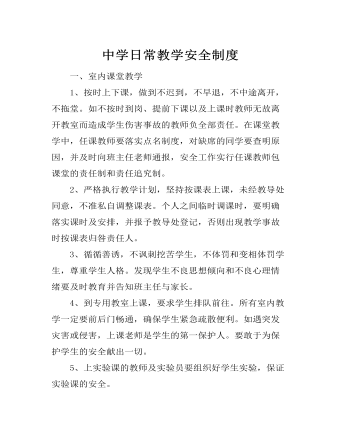
中学日常教学安全制度
2、严格执行教学计划,坚持按课表上课,未经教导处同意,不准私自调整课表。个人之间临时调课时,要明确落实课时及安排,并报予教导处登记,否则出现教学事故时按课表归咎责任人。 3、循循善诱,不讽刺挖苦学生,不体罚和变相体罚学生,尊重学生人格。发现学生不良思想倾向和不良心理情绪要及时教育并告知班主任与家长。 4、到专用教室上课,要求学生排队前往。所有室内教学一定要前后门畅通,确保学生紧急疏散便利。如遇突发灾害或侵害,上课老师是学生的第一保护人。要敢于为保护学生的安全献出一切。
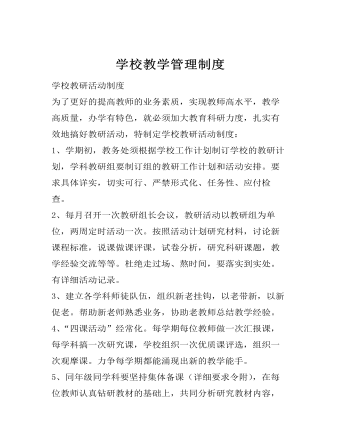
学校教学管理制度
1、学期初,教务处须根据学校工作计划制订学校的教研计划,学科教研组要制订组的教研工作计划和活动安排。要求具体详实,切实可行、严禁形式化、任务性、应付检查。 2、每月召开一次教研组长会议,教研活动以教研组为单位,两周定时活动一次。按照活动计划研究材料,讨论新课程标准,说课做课评课,试卷分析,研究科研课题,教学经验交流等等。杜绝走过场、熬时间,要落实到实处。有详细活动记录。
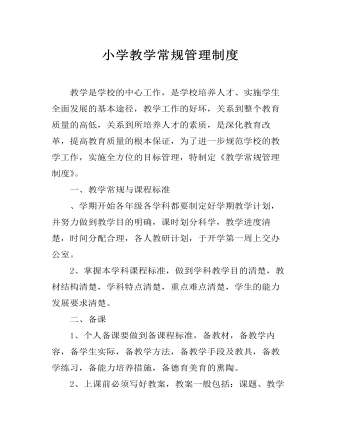
小学教学常规管理制度
一、教学常规与课程标准 、学期开始各年级各学科都要制定好学期教学计划,并努力做到教学目的明确,课时划分科学,教学进度清楚,时间分配合理,各人教研计划,于开学第一周上交办公室。 2、掌握本学科课程标准,做到学科教学目的清楚,教材结构清楚,学科特点清楚,重点难点清楚,学生的能力发展要求清楚。 二、备课 1、个人备课要做到备课程标准,备教材,备教学内容,备学生实际,备教学方法,备教学手段及教具,备教学练习,备能力培养措施,备德育美育的熏陶。 2、上课前必须写好教案,教案一般包括:课题、教学目标、重点难点、教学用具、教学过程、实验操作、作业布置、板书设计、课后小结。学期中应超前一周备课、教案字清楚整洁。 3、不得使用旧教案或以参考资料代替教案。
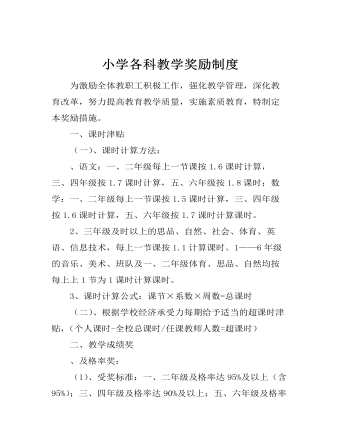
小学各科教学奖励制度
一、课时津贴 (一)、课时计算方法: 、语文:一、二年级每上一节课按1.6课时计算,三、四年级按1.7课时计算,五、六年级按1.8课时;数学:一、二年级每上一节课按1.5课时计算,三、四年级按1.6课时计算,五、六年级按1.7课时计算课时。 2、三年级及时以上的思品、自然、社会、体育、英语、信息技术,每上一节课按1.1计算课时。1——6年级的音乐、美术、班队及一、二年级体育、思品、自然均按每上上1节为1课时计算课时。 3、课时计算公式:课节×系数×周数=总课时 (二)、根据学校经济承受力每期给予适当的超课时津贴,(个人课时-全校总课时/任课教师人数=超课时) 二、教学成绩奖 、及格率奖: (1)、受奖标准:一、二年级及格率达95%及以上(含95%);三、四年级及格率达90%及以上;五、六年级及格率达85%及以上才能受奖。 (2)、奖励办法:凡达到标准要求者,根据所教班学生数,按每生1元计算,奖单科教师。 2、优生率奖: (1)、优生标准:一、二年级95分以上者;三、四年级90及以上者;五、六年级90分及以上者为优生。 (2)、奖励方法:按每科计算,优生每生奖1元。语文、数学双科优生,每生奖2元。 3、特优生奖:10元/生。 4、平均分奖:以区平均比较,每超一个百分点,按每生0.1元计奖。
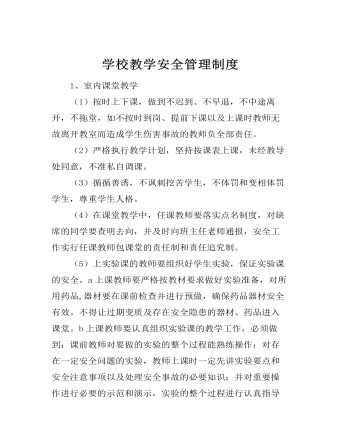
学校教学安全管理制度
(2)严格执行教学计划,坚持按课表上课,未经教导处同意,不准私自调课。 (3)循循善诱,不讽刺挖苦学生,不体罚和变相体罚学生,尊重学生人格。 (4)在课堂教学中,任课教师要落实点名制度,对缺席的同学要查明去向,并及时向班主任老师通报,安全工作实行任课教师包课堂的责任制和责任追究制。 (5)上实验课的教师要组织好学生实验,保证实验课的安全。a上课教师要严格按教材要求做好实验准备,对所用药品,器材要在课前检查并进行预做,确保药品器材安全有效。不得让过期变质及存在安全隐患的器材、药品进入课堂。b上课教师要认真组织实验课的教学工作,必须做到:课前教师对要做的实验的整个过程能熟练操作;对存在一定安全问题的实验,教师上课时一定先讲实验要点和安全注意事项以及处理安全事故的必要知识;并对重要操作进行必要的示范和演示,实验的整个过程进行认真指导和全面监控,确保学生安全。c所有学生必须严格遵守实验室管理制度及操作规程,严格遵守操作规程及实验步骤,不懂就问,有问题及时向老师汇报。
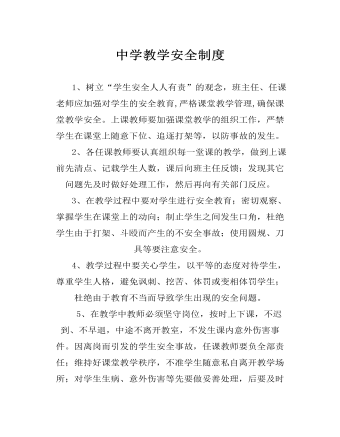
中学教学安全制度
2、各任课教师要认真组织每一堂课的教学,做到上课前先清点、记载学生人数,课后向班主任反馈;发现其它问题先及时做好处理工作,然后再向有关部门反应。 3、在教学过程中要对学生进行安全教育;密切观察、掌握学生在课堂上的动向;制止学生之间发生口角,杜绝学生由于打架、斗殴而产生的不安全事故;使用圆规、刀具等要注意安全。 4、教学过程中要关心学生,以平等的态度对待学生,尊重学生人格,避免讽刺、挖苦、体罚或变相体罚学生;杜绝由于教育不当而导致学生出现的安全问题。
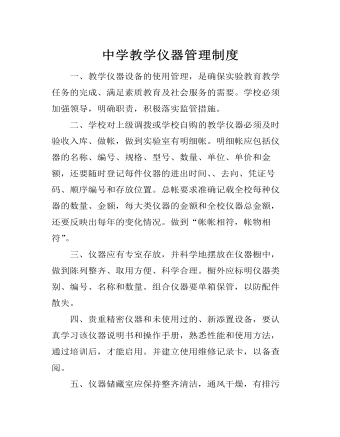
中学教学仪器管理制度
二、学校对上级调拨或学校自购的教学仪器必须及时验收入库、做帐,做到实验室有明细帐。明细帐应包括仪器的名称、编号、规格、型号、数量、单位、单价和金额,还要随时登记每件仪器的进出时间、、去向、凭证号码、顺序编号和存放位置。总帐要求准确记载全校每种仪器的数量、金额,每大类仪器的金额和全校仪器总金额,还要反映出每年的变化情况。做到“帐帐相符,帐物相符”。 三、仪器应有专室存放,并科学地摆放在仪器橱中,做到陈列整齐、取用方便、科学合理。橱外应标明仪器类别、编号、名称和数量。组合仪器要单箱保管,以防配件散失。





















